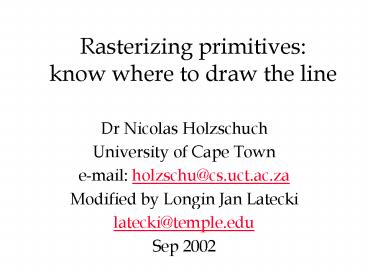Rasterizing primitives: know where to draw the line PowerPoint PPT Presentation
1 / 23
Title: Rasterizing primitives: know where to draw the line
1
Rasterizing primitives know where to draw the
line
- Dr Nicolas Holzschuch
- University of Cape Town
- e-mail holzschu_at_cs.uct.ac.za
- Modified by Longin Jan Latecki
- latecki_at_temple.edu
- Sep 2002
2
Rasterization of Primitives
- How to draw primitives?
- Convert from geometric definition to pixels
- rasterization selecting the pixels
- Will be done frequently
- must be fast
- use integer arithmetic
- use addition instead of multiplication
3
Rasterization Algorithms
- Algorithmics
- Line-drawing Bresenham, 1965
- Polygons uses line-drawing
- Circles Bresenham, 1977
- Currently implemented in all graphics libraries
- Youll probably never have to implement them
yourself
4
Why should I know them?
- Excellent example of efficiency
- no superfluous computations
- Possible extensions
- efficient drawing of parabolas, hyperbolas
- Applications to similar areas
- robot movement, volume rendering
- The CG equivalent of Eulers algorithm
5
Map of the lecture
- Line-drawing algorithm
- naïve algorithm
- Bresenham algorithm
- Circle-drawing algorithm
- naïve algorithm
- Bresenham algorithm
6
Naïve algorithm for lines
- Line definition axbyc 0
- Also expressed as y mx d
- m slope
- d distance
- For xxmin to xmax
- compute y mxd
- light pixel (x,y)
7
Extension by symmetry
- Only works with -1 m 1
m 3
m 1/3
Extend by symmetry for m gt 1
8
Problems
- 2 floating-point operations per pixel
- Improvements
- compute y mpd
- For xxmin to xmax
- y m
- light pixel (x,y)
- Still 1 floating-point operation per pixel
- Compute in floats, pixels in integers
9
Bresenham algorithm core idea
- At each step, choice between 2 pixels
- (0 m 1)
or that one
Either I lit this pixel
Line drawn so far
10
Bresenham algorithm
- I need a criterion to pick between them
- Distance between line and center of pixel
- the error associated with this pixel
Error pixel 2
Error pixel 1
11
Bresenham Algorithm (2)
- The sum of the 2 errors is 1
- Pick the pixel with error lt 1/2
- If error of current pixel lt 1/2,
- draw this pixel
- Else
- draw the other pixel. Error of current pixel 1
- error
12
How to compute the error?
- Origin (0,0) is the lower left corner
- Line defined as y ax c
- Distance from pixel (p,q) to line d y(p) q
ap - q c - Draw this pixel iff ap - q c lt 1/2
- Update for next pixel
- x 1, d a
13
Were still in floating point!
- Yes, but now we can get back to integere 2ap
- 2q 2c - 1lt 0 - If elt0, stay horizontal, if egt0, move up.
- Update for next pixel
- If I stay horizontal x1, e 2a
- If I move up x1, y1, e 2a - 2
14
Bresenham algorithm summary
- Several good ideas
- use of symmetry to reduce complexity
- choice limited to two pixels
- error function for choice criterion
- stay in integer arithmetics
- Very straightforward
- good for hardware implementation
- good for assembly language
15
Circle naïve algorithm
- Circle equation x2y2-r2 0
- Simple algorithm
- for x xmin to xmax
- y sqrt(rr - xx)
- draw pixel(x,y)
- Work by octants and use symmetry
16
Circle Bresenham algorithm
- Choice between two pixels
or that one
Either I lit this pixel
Circle drawn so far
17
Bresenham for circles
- Mid-point algorithm
E
SE
If the midpoint between pixels is inside the
circle, E is closer, draw E If the midpoint is
outside, SE is closer, draw SE
18
Bresenham for circles (2)
- Error function d x2y2 - r2
- Compute d at the midpoint
- If the last pixel drawn is (x,y),
- then E (x1,y), and SE (x1,y-1).
- Hence, the midpoint (x1,y-1/2).
- d(x,y) (x1)2 (y - 1/2)2 - r2
- d lt 0 draw E
- d ³ 0 draw SE
19
Updating the error
- In each step (go to E or SE), i.e., increment x
x1 - d 2x 3
- If I go to SE, i.e., x1, y-1
- d -2y 2
- Two mult, two add per pixel
- Can you do better?
20
Doing even better
- The error is not linear
- However, what I add to the error is
- Keep Dx and Dy
- At each step
- Dx 2, Dy -2
- d Dx
- If I decrement y, d Dy
- 4 additions per pixel
21
Midpoint algorithm summary
- Extension of line drawing algorithm
- Test based on midpoint position
- Position checked using function
- sign of (x2y2-r2)
- With two steps, uses only additions
22
Extension to other functions
- Midpoint algorithm easy to extend to any curve
defined by f(x,y) 0 - If the curve is polynomial, can be reduced to
only additions using n-order differences
23
Conclusion
- The basics of Computer Graphics
- drawing lines and circles
- Simple algorithms, easy to implement with
low-level languages

